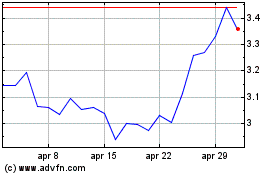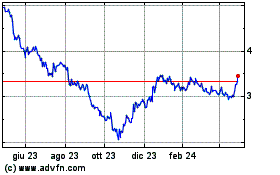Aquafil – Helping Define the Circular Business Model of the Future
20 Giugno 2024 - 4:17PM

Aquafil SpA (ECNLF:OTCQX – ECNL:IM), based in Arco
(TN) Italy and a pioneer of the circular economy, believes now is
the time for business leaders to make a radical shift. If we are to
continue driving toward a circular economy, businesses must think
beyond how they can create circular products and also begin
developing and adopting circular business models.
There is especially an opportunity for this
shift within the interior design and architecture space, where
products and materials are frequently used and switched out. The
common business model in today’s design industry still struggles to
create with the end in mind: spaces are created to be used for a
specific purpose and not optimized to be re-used again. Research
from LMN Architects recently discovered that this cycle of waste
has built a cumulative carbon impact that is even greater than the
emissions generated by the structure of the building itself.
By transitioning to innovative business models
with a circular focus, design businesses will still be able to
share important products with customers while reducing resource
extraction on one end and waste buildup on the other. Some of the
circular business models of the future that we’re starting to see
are products as services, product use extension and take-back
programs.
Products as Services
One of the latest innovative business models
we’re seeing is one where items that were typically sold as
products are now being sold as services. The Ellen MacArthur
Foundation highlights a few organizations practicing this model,
from lighting-as-a-service, where customers pay a monthly fee for
light while the business manages the installation, operation and
maintenance of the lighting systems, to furniture-as-a-service,
where customers pay a monthly fee for furniture and return it when
no longer needed.
These service models enable customers to keep up
with the latest and greatest products without contributing to
waste. Businesses are able to take back the products when they
start to wear and tear or the customer no longer needs them,
finding ways to reuse the materials or get them ready for a new
customer. The success of the business changes from volume to
performance, therefore extending the life of the product. This
mindset shift will also mean a shift in the way products are
designed, as designers and manufacturers are incentivized to create
products that are longer lasting and use ingredients that withstand
wear and tear for longer. Businesses that turn to the product as a
service model will have to consider the durability and impact of
the materials they work with in a way they hadn’t before.
Product Use Extension
Another circular business model explores
opportunities to extend the life of a product after its use. In the
architecture and construction space, this can mean finding ways to
renovate existing spaces with existing materials rather than
bulldozing and starting fresh. A recent Bloomberg article
highlights how the U.S. economy is already moving in this direction
as renovations have overtaken new construction in architectural
billings for the first time in 20 years.
Architects are typically inspired to create
something new, but there needs to be a shift in excitement to
transform older buildings just as well, especially with a circular
mindset. Not only does it create more carbon emissions when we
build a new structure, there are also outdated energy systems and
embodied carbon within materials of older buildings that contribute
nearly 40% of total global greenhouse gas emissions, according to
the Global Alliance for Building and Construction. Architects have
the opportunity and responsibility to apply circular design
principles to already built environments in order to combat these
issues and extend the life of their products: in this case,
buildings.
For interior design, product use extension can
mean creating modular products that can easily be taken apart.
Take-Back Programs
Take-back programs will likely be the easiest
transition for traditional business models into more circular
practices, although they will require innovative logistics. Often,
organizations with this model have developed a way to reutilize the
materials from used products to create new products, enabling the
business to rely less on resource extraction. It also tends to
build a strong loyalty with customers who have an incentive to
continue buying products, knowing they will either be able to trade
it in for a newer model or receive a payment of some kind.
The take-back model has already been adopted
within the fashion industry, especially with businesses that are
already using recycled and regenerated ingredients in their design.
However, there is an opportunity for the design industry to also
utilize this model. For example, Aquafil’s carpet recycling centers
have provided Aquafil a way to take back nylon-based products like
carpet and fabric scraps that would otherwise end up in landfills
to create ECONYL® regenerated nylon. In states like California and
now New York with carpet recycling laws, businesses are even
incentivized to recycle their carpet, benefitting the recycler, the
business receiving the recycled materials as well as the
environment.
Building a Circular Business
Model
Moving from a linear to a circular economic
model brings multiple benefits, including the reduction of pressure
on the environment, the optimization of the availability of raw
materials and an inevitable boost to innovation and economic
growth. The companies that lead the way with circular business
models have given us an example of what is possible and an
inspiring hope for our future economy.
Over 10 years ago Aquafil recognized the virtue
and value of the Circular Economy and eco-design. Since then, the
Company has invested hundreds of millions of Euros in developing
technologies and building facilities to produce an infinitely
recyclable version of Nylon 6: ECONYL® regenerated nylon. The
latter maintains the same quality level and performance as standard
nylon, has the same wearing features as material from fossil fuel
and can help you closing the loop.
Today, Aquafil generates over 52% of its fibers
revenues from the ECONYL® regeneration products (1Q 2024 revenues
amounted to Euro 147.5 mln). The goal is to continually increase
this proportion targeting 60% to 2025.
About Aquafil SpA
Since 1965, the Aquafil Group has been a pioneer
of the circular economy and a landmark in terms of quality and
product innovation for Italy and the globe. We primarily
manufacture Nylon 6 fibers and polymers but also Nylon 6.6 and
Dryarn. Our flagship product is ECONYL® nylon, which revolutionizes
the world of synthetic fibers through a closed-loop model.
Today, Aquafil remains a leader in the research
of new production systems for sustainable development.
To keep current on Aquafil, please go to
www.aquafil.com.
Investors ContactGiulia Rossi
investor.relations@aquafil.commob: +39 327 0820.268
Media Contact Maria Giovanna
Sandrini maria.giovanna.sandrini@aquafil.commob: +39 348
6019.628
U.S. Contact:Joe
Hassettjoeh@gregoryfca.com610-787-0464 (Cell)
Grafico Azioni Aquafil (BIT:ECNL)
Storico
Da Feb 2025 a Mar 2025

Grafico Azioni Aquafil (BIT:ECNL)
Storico
Da Mar 2024 a Mar 2025
